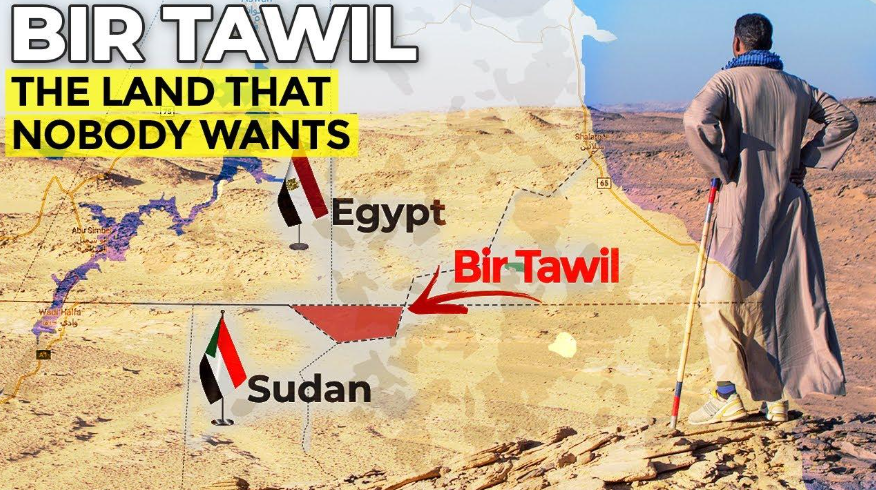Bir Tawil—a desolate, unclaimed piece of desert between Egypt and Sudan—is one of the world’s last true no man’s lands. At just over 2,060 square kilometers, this barren territory has fascinated explorers, adventure seekers, and even micronation enthusiasts for years.
While it may seem like an insignificant stretch of land, Bir Tawil represents one of the last places on earth that no nation claims as its own, giving it a unique status in international geopolitics and among those who dream of founding their own country. This is the tale of Bir Tawil—its history, its bizarre micronation claims, and why you can’t visit it right now.
The History of Bir Tawil
Bir Tawil’s curious position stems from a border dispute between Egypt and Sudan dating back to the early 20th century. When the British ruled over both nations, they created two borders: the political boundary of 1899 and the administrative boundary of 1902. Egypt recognizes the former, while Sudan acknowledges the latter. This dispute created two unique regions—Bir Tawil and Hala’ib Triangle—but with a twist: Egypt wants Hala’ib, and Sudan wants it too, while neither nation wants Bir Tawil. The result? Bir Tawil is left in legal limbo, unclaimed by any recognized state.
The lack of natural resources or strategic value means that neither country is willing to stake a claim, creating the rare and curious situation of a landmass that nobody truly wants. This has left Bir Tawil as one of the world’s few terra nullius—land belonging to no nation.
Micronation Madness
The fact that Bir Tawil is unclaimed has naturally drawn the attention of micronation enthusiasts. Over the years, several people have staked their claim to this patch of desert, each hoping to establish their own sovereign state. The most famous claim came in 2014, when Jeremiah Heaton, an American, traveled to Bir Tawil, planted a flag, and declared the area the Kingdom of North Sudan so that his daughter could be a princess. Heaton’s claim, while headline-grabbing, was met with skepticism and remains unrecognized by any government.
Other would-be rulers include the Kingdom of Dixit, claimed by an Indian man who even designed his own flag, and Dominion of Melchizedek, which has drawn even more obscure and imaginative claims. While these micronations provide entertainment and a quirky side to Bir Tawil’s story, they underscore the larger point: Bir Tawil remains a land without a real nation.
The Adventure to Bir Tawil
I was fortunate enough to organize a documented trip to Bir Tawil before the current geopolitical turmoil made it unreachable. This journey was highlighted in the book “The Men in No Man’s Land,” which tells the story of our exploration into this unclaimed territory. For those with an appetite for adventure, Bir Tawil represented the ultimate off-the-beaten-track destination. Getting there involved navigating through some of the harshest conditions on the planet—a punishing journey over scorching desert sands, without a soul in sight for miles. It was a place that truly embodied “the middle of nowhere.”
Our trips, which often felt like stepping into a geopolitical oddity, took explorers deep into the world of terra nullius. However, the experience is about more than just the desert—it’s about reflecting on how arbitrary borders and human politics can leave such places forgotten by the world. Sadly, given the ongoing conflict between Sudan and Egypt, our travels to Bir Tawil have been temporarily halted. As of now, the route to the territory is cut off, a fact that most people remain blissfully unaware of.
Why You Can’t Visit Bir Tawil Anymore
The ongoing war in Sudan, combined with tensions in Egypt, has complicated access to Bir Tawil. Even though the region itself is unclaimed and uninhabited, the political instability surrounding it has made travel there incredibly dangerous. Currently, Sudan is embroiled in a devastating internal conflict, while Egypt has ramped up security along its border. Unfortunately, this means that Bir Tawil is out of reach for the foreseeable future, even for the most intrepid explorers.
What’s particularly frustrating is that many people don’t even realize this. Bir Tawil, once a quiet haven for micronation enthusiasts and off-grid adventurers, is now caught up in the larger geopolitical drama of the region. While it may not be a priority for world governments, this little slice of no man’s land has become another victim of the broader instability.
The Enduring Fascination
What is it about Bir Tawil that continues to fascinate? Perhaps it’s the allure of its isolation—of a place where you can escape the grasp of modern nation-states and forge your own path. For micronation fans, it represents the ultimate blank canvas. For explorers, it offers the kind of adventure you just don’t get in today’s over-mapped world. And for geopolitical nerds, it’s a curious case study in how borders and nationhood can be manipulated—or forgotten altogether.
Though Bir Tawil is currently inaccessible, its story isn’t over. One day, perhaps the turmoil will subside, and the path to Bir Tawil will open again. Until then, the land will remain what it has always been—a forgotten corner of the world, claimed by no one, and visited by only a few.

